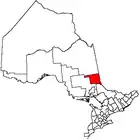Cobalt, Ontario
Cobalt is a town in Timiskaming District, Ontario, Canada. It had a population of 1,118 at the 2016 Census.
Cobalt, Ontario | |
|---|---|
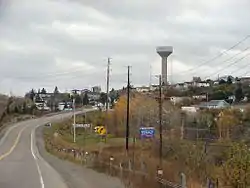 | |
| Nickname(s): Silver City | |
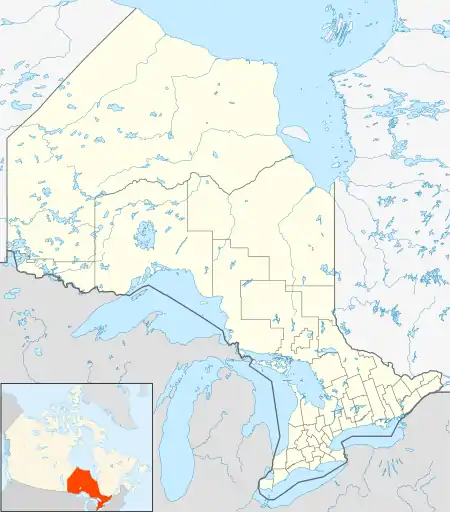 Cobalt, Ontario | |
| Coordinates: 47°24′N 79°41′W | |
| Country | Canada |
| Province | Ontario |
| District | Timiskaming |
| Government | |
| • Mayor | George Othmer |
| • Governing Body | Cobalt Town Council |
| • MPs | Anthony Rota (LIB) |
| • MPPs | John Vanthof (ONDP) |
| Area | |
| • Land | 1.44 km2 (0.56 sq mi) |
| Population (2016)[1] | |
| • Total | 1,118 |
| • Density | 776.0/km2 (2,010/sq mi) |
| Time zone | UTC-5 (EST) |
| • Summer (DST) | UTC-4 (EDT) |
| Postal code | P0J 1C0 |
| Area code(s) | 705, 249 |
| Website | cobalt.ca |
In the early 1900s, the area was heavily mined for silver; the silver ore also contained cobalt. By 1910, the community was the fourth highest producer of silver in the world.[2] Mining declined significantly by the 1930s, together with the local population. In late 2017 one publication referred to Cobalt as a ghost town, but the high demand for cobalt, used in making batteries for mobile devices and electric vehicles, is leading to great interest in the area among mining companies.[3]
History
.jpg.webp)

W.E. Logan discovered cobalt in 1884 at the future site of the Agaunico Mine, one mile south of Haileybury.[4]
Silver was discovered in the area during the construction of the Temiskaming & Northern Ontario Railway (T&NO) from North Bay to the communities of Haileybury and New Liskeard, north of Cobalt. The discovery was made in 1903,[5] near Long Lake (later called Cobalt Lake), by Ernest Darragh and James McKinley, who were supplying railway ties. Later that year, Tom Hébert found a rich vein on the east side of Cobalt Lake and began a business with hotel owner Arthur Ferland.[6] The silver from both sites was consistently high-grade.[7]
Boomtown
The subsequent Cobalt silver rush led to the development of the McKinley Darragh, La Rose, Nipissing, and O'Brien silver mines. In 1904, Willet Miller, on a visit to Mile 104 on the T&NO, along with brothers Noah and Henry Timmins, named the future town Cobalt. The Timmins brothers bought the remaining claims from Fred La Rose, and erected some cabins.[4]:18
Speculation over mining stocks on Wall Street in New York City required mounted police to control the crowds. The town was incorporated in 1906.[4]:32,40
By 1908, the camp was considered the world's largest producer of silver and of the cobalt which is a byproduct of the process.[8]
In 1911, the 34 mines produced over 30 million ounces (937.5 tons) of silver. The town's population soared to 10,000 by 1909.[9] Mining continued until the 1930s, then slowed to a trickle. Activity renewed in the 1950s then slowly dropped off, and since the 1980s, there have been no operating mines in the area. By the 1960s, the area had produced over 420 million ounces of silver.[10] One mill still operated in the area in 2017, and exploration for diamonds and other minerals was ongoing.[3][11]
The silver mines of Cobalt, and the prospectors and miners who discovered them and worked them, left an indelible mark on Canadian history, and the town is known as the birthplace of hard rock mining in Canada. The ore in Cobalt was close to surface, so men with limited experience could prospect, begin mining, and then hone their skills as the mines went deeper. Those who learned their trade in Cobalt moved north, discovering gold in Kirkland Lake and Timmins and further afield in Canada and around the world. Cobalt mining was done with the use of wheelbarrows, pickaxes, hand steel and dynamite.
Fires
Cobalt suffered two devastating fires in the 20th century. In 1909, a fire in a cafe spread quickly through debris and garbage-filled alleyways. Half the town was destroyed; 150 buildings were lost and 3,000 residents left homeless; by that time the water table had been contaminated and a typhoid outbreak earlier in the year had killed 111 people.[9] Fire protection at the time was inadequate and firefighters were forced to dynamite buildings to create a firebreak.[12] On a hot and windy Victoria Day in 1977, a discarded cigarette started a fire that destroyed 140 buildings and left over 400 homeless.[13][14]
Hockey
The Cobalt Silver Kings played in the inaugural 1910 NHA season.
Administration
Cobalt, Haileybury, and New Liskeard were formerly known as the Tri-Towns[15]. When Haileybury and New Liskeard were amalgamated into the city of Temiskaming Shores in 2004, Cobalt decided to remain a separate town. However, the two municipalities continue to have a close relationship, including the operation of a shared public transit system.
In 2001 Cobalt was named "Ontario's Most Historic Town" by a in panel of judges on the TV Ontario program Studio 2, and in 2002 the "Cobalt Mining District" was designated a National Historic Site of Canada.[16]
Renewed interest in cobalt and silver mining
Cobalt is a byproduct of silver mining and was not of significant interest as a mineral until recently; in fact, many considered it to be a "nuisance".[17] Today, however, it is a critical component in the types of rechargeable lithium battery used in millions of mobile devices and in electric cars,[18] and demand is expected to increase.[19] This application for the mineral was not yet possible in the mid-1980s[20] when the last mining company, Agnico Eagle Mines Limited, ceased operations in the area.[11] Cobalt is always mixed not only with silver but also with copper, nickel and other metals.[21]
By 2017, several cobalt exploration companies were focusing on the area around Cobalt,[22] as one alternative to cobalt mining in the politically-unstable Democratic Republic of Congo.[23] Roughly 60% of the world's cobalt is mined in the Congo, much of it using child labour in very poor working conditions. Major companies that require this mineral for their batteries were searching for ethically-sourced product.[24] The shortage of such cobalt is a primary reason for the 300% increase in the price of this commodity since 2015.[25]
Stock prices of First Cobalt Corp. and Cobalt 27 Capital Corp. had soared in 2017 based on this prospect. The CEO of First Cobalt made this comment after returning from a trip to the U.S., Europe, Australia and Asia: "We've got some of the biggest resource companies in the world interested".[11] In October, the company was planning to prospect the Caswell, Ophir and Silver Banner areas, as well as mines around Kerr Lake and Maiden Lake, via the staff of Bjorkman Prospecting of Whiskey Jack, Ontario.[26] At the time, First Cobalt was negotiating a merger with two other companies, Cobalt One and CobalTech.[27] If the merger is completed, the group expected to control about 45% of the potential mining properties in the Cobalt area including 50 mines that previously produced cobalt and silver; a competitor, Agnico Eagle, controls approximately 21%.[28] However the latter ceased production there in the 1980s.
Silver was selling for US$17 per ounce in late November 2017, down significantly from its peak of US$50 in 2012,[29] but cobalt was at about US$31 per pound at that time, up significantly from the US$10 price in late 2015.[30] The prices will increase according to Gino Chitaroni, the president of the Northern Prospectors' Association. He also predicted that the area around Cobalt would be a primary source of both minerals. "It's spectacular ... We have the infrastructure. We have a historic mining area. It puts us a step up on anywhere [else] in the world."[17]
In March 2017, the town's mayor estimated that mining production could start in about three to five years.[31]
Demographics
| Year | Pop. | ±% |
|---|---|---|
| 1911 | 5,638 | — |
| 1921 | 4,449 | −21.1% |
| 1931 | 3,885 | −12.7% |
| 1941 | 2,376 | −38.8% |
| 1951 | 2,230 | −6.1% |
| 1961 | 2,209 | −0.9% |
| 1971 | 2,197 | −0.5% |
| 1981 | 1,759 | −19.9% |
| 1991 | 1,470 | −16.4% |
| 1996 | 1,401 | −4.7% |
| 2001 | 1,229 | −12.3% |
| 2006 | 1,224 | −0.4% |
| 2011 | 1,122 | −8.3% |
| 2016 | 1,118 | −0.4% |
| [1] | ||
| Canada census – Cobalt, Ontario community profile | |||
|---|---|---|---|
| 2016 | 2011 | 2006 | |
| Population: | 1,118 (-0.4% from 2011) | 1,133 (-7.4% from 2006) | 1,223 (0.0% from 2001) |
| Land area: | 1.44 km2 (0.56 sq mi) | 2.05 km2 (0.79 sq mi) | 2.11 km2 (0.81 sq mi) |
| Population density: | 776.0/km2 (2,010/sq mi) | 553.0/km2 (1,432/sq mi) | 582.8/km2 (1,509/sq mi) |
| Median age: | 47.5 (M: 47.2, F: 47.7) | 46.5 (M: 46.1, F: 47.0) | 43.9 (M: 43.1, F: 44.8) |
| Total private dwellings: | 611 | 559 | 569 |
| Median household income: | $42,816 | $31,470 | |
| Notes: Includes corrections and updates – References: 2016[32] 2011[33] 2006[34] earlier[35] | |||
Mother tongue (2006):[34]
- English as first language: 76.0%
- French as first language: 19.5%
- English and French as first language: 2.0%
- Other as first language: 2.4%
Environmental issues
The mining activities in Cobalt have left a significant environmental legacy. Millions of tons of mine waste rock and mill tailings were dumped on the land and in local lakes. In cobalt ores, silver was associated with arsenic minerals. Little of this arsenic was ever recovered, with most of it ended up in the tailings and waste rock. Today this arsenic contaminates surface water in the area and poses risks to the environment. Sediment samples from surrounding lakes showed elevated concentration levels of nickel, copper and arsenic while water samples exceeded the provincial water quality guideline for cobalt and arsenic.[36] Fish from five of the lakes around Cobalt had mercury concentration which exceeded the consumption limit as well as elevated concentration for arsenic.[36]
The Cobalt area is also laced with many miles of underground mine workings, surface trenches, pits and shaft openings. As a result, there are risks of collapse, or subsidence of underground mine workings, and many areas have been fenced off to prevent entry.
Tourism and attractions
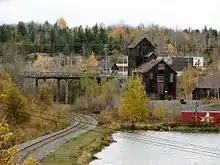
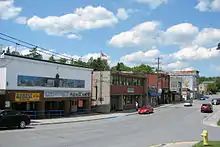
Visitors to Cobalt can visit the Cobalt Mining Museum, which boasts the world's largest display of silver, as well as "The Bunker" military museum and the Northern Ontario Firefighters Museum.[37] The Heritage Silver Trail is a self-guided driving tour of several mine and mill sites in the area. The trail is well marked, guiding visitors around the backroads of Cobalt. At each site, signs are posted, identifying the site, and providing a brief description of the site.[38] The trail guides visitors to many of the remaining mine headframes in the Cobalt area, some of which are quite picturesque, and stand as an important reminder of Cobalt's past.
Visitors can also take a tour of an old underground mine. Tours start at the Mining Museum, and are guided by museum staff. The narrow damp tunnels of the mine give a real appreciation for the conditions under which miners worked, and tour guides sprinkle the tour with many stories to help bring the past to life.[39]
On February 14, 2008, plans were announced to convert the vacant Fraser Hotel building into a complex which will include The Bunker museum, housing units, tourist accommodations, and a proposed culinary school.[40]
Passenger rail service continued to be provided from the Cobalt railway station on the Ontario Northland Railway's Northlander train (it was during the building of this line that silver had been discovered in Cobalt) until it was discontinued on September 28, 2012.
A notable tourist attraction in the area in the 20th century was the Highway Book Shop, which closed in 2011.
Notable people
- Charlie Angus, federal Member of Parliament for Timmins—James Bay
- Mike Bolan, former provincial MPP
- Kent Douglas, hockey player, winner of the Calder Memorial Trophy in 1963.
- Edward James Gibson Holland, awarded the Victoria Cross for service in the Boer War died in Cobalt in 1948.
- Walter Frederick Light, President of Northern Telecom 1974-1979, CEO and chairman of Northern Telecom 1979-1984.
- Bruce Lonsdale, former mayor of Cobalt and federal Member of Parliament for Timiskaming
- Elmer Sopha, former provincial MPP
References
- "Census Profile, 2016 Census - Cobalt [Population centre], Ontario and Newfoundland and Labrador [Province]". 2.statcan.gc.ca. Retrieved 2018-07-31.
- "Cobalt (Ont)".
- "The PayPal Mafia of Self-Driving Cars Has Been at It a Decade".
- Barnes, Michael (1986). Fortunes in the Ground. Erin, Ontario: The Boston Mills Press. p. 13. ISBN 091978352X.
- "The Rise and Fall of a Mining Camp". Cobalt Mining Legacy. Retrieved July 20, 2019.
- "Canada's forgotten silver boomtown". magazine.cim.org.
- "Dipping into the silver stream". magazine.cim.org.
- Pain, S.A. (1960). Three Miles of Gold. Toronto: The Ryerson Press. pp. 2–3.
- "A Glimpse Into the History of Cobalt, Ontario".
- "History of Cobalt — Town of Cobalt". cobalt.ca.
- "The Canadian Ghost Town That Tesla Is Bringing Back to Life".
- The Cobalt Adventure. Retrieved on 2015-03-08.
- "Terrible fires shaped Tri-Towns - JOHN R. HUNT's On the Rocks". North Bay Nugget. 24 May 2011. Archived from the original on 2 April 2015. Retrieved 8 March 2015.
- The Cobalt Adventure. Retrieved on 2015-03-08.
- Barnes, Michael (2000). The Tri-Towns: Cobalt, Haileybury, and New Liskeard. Highway Book Shop. ISBN 0889544123.
- Cobalt Mining District National Historic Site of Canada. Canadian Register of Historic Places. Retrieved 15 September 2013.
- nurun.com. "ACCENT: Cobalt could take centre stage again". Sudbury Star.
- West, Karl (29 July 2017). "Carmakers' electric dreams depend on supplies of rare minerals". the Guardian.
- Shilling, Erik. "We May Not Have Enough Minerals To Even Meet Electric Car Demand".
- "Cobalt Mining Legacy". Cobaltmininglegacy.ca. 1903-08-15. Retrieved 2018-07-31.
- "Boom times ahead in the Cobalt camp".
- "As Cobalt Supply Tightens, LiCo Energy Metals Announces Two New Cobalt Mines - CleanTechnica". cleantechnica.com.
- "Boom times ahead in the Cobalt camp".
- "Subscribe to read". Financial Times. Cite uses generic title (help)
- "Tesla & GE Face Major Shortage Of Ethically Sourced Cobalt". 31 May 2017.
- "First Cobalt starts exploration work at Cobalt property".
- "First Cobalt Commences Exploration on Cobalt One and CobalTech Properties". Marketwired.com. Retrieved 2018-07-31.
- "Cobalt: First Cobalt proposes mergers with Cobalt One and CobalTech - Canadian Mining Journal". 26 June 2017.
- "Silver Spot Price Live Chart - BullionVault". www.bullionvault.com.
- "Electric cars yet to turn cobalt market into gold mine - Nornickel - MINING.com".
- "'Like an old fashioned staking rush' mining companies buy land in Cobalt, Ont. - CBC News".
- "2016 Community Profiles". 2016 Canadian Census. Statistics Canada. February 21, 2017. Retrieved 2019-07-20.
- "2011 Community Profiles". 2011 Canadian Census. Statistics Canada. July 5, 2013. Retrieved 2012-07-09.
- "2006 Community Profiles". 2006 Canadian Census. Statistics Canada. March 30, 2011. Retrieved 2012-07-09.
- "2001 Community Profiles". 2001 Canadian Census. Statistics Canada. February 17, 2012.
- Andrew Leung (March 2009). Heavy Metals in Sediments, Water and Fish from the lakes of Cobalt, Ontario (Report). Ontario Ministry of the Environment.
- "Museums — Town of Cobalt". Town of Cobalt. Retrieved 2017-02-18.
- "Cobalt Historical Society~Heritage Silver Trail". heritagesilvertrail.ca. Retrieved 2021-01-15.
- "Tours — Town of Cobalt". Retrieved 2021-01-15.
- "The Temiskaming Speaker".
